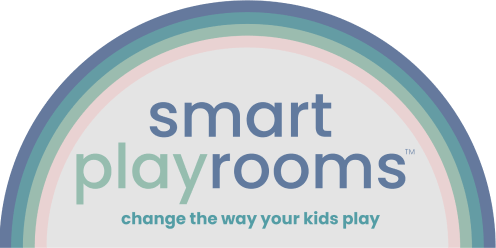At Smart Playrooms, we specialize in transforming every space—no matter how challenging—into a world of imaginative and active play. One of the most common architectural challenges we face is slanted ceilings. While these angled structures add charm and character to a room, they can pose difficulties when designing with larger or hanging equipment like monkey bars, swings, ninja cones, and trapeze bars. The good news? We thrive on finding creative, safe, and functional solutions for these unique spaces.
In this blog, we’ll walk you through how we design around slanted ceilings while still incorporating our most beloved products like the Monkey Bars, Ninja Cones and Rings, Ropes, Cocoon Swings, Trapeze Bars, Furry Swings, and Flower Swings.
Why Slanted Ceilings Are No Obstacle
Many playrooms are located in attics, lofts, or top-floor bonus rooms—areas where sloped ceilings are the norm. While you may initially think that a slanted ceiling limits what can be installed, we see it as a design opportunity. By mapping the pitch of the ceiling, identifying the highest clearance points, and strategically utilizing wall studs and horizontal crossbeams, we can make even the most awkward angles work for active play.
1. Monkey Bars and Ceiling Clearance
Monkey Bars are one of our most requested pieces of equipment—and for good reason. They promote upper body strength, spatial awareness, and endless climbing fun. When working with slanted ceilings, our approach includes:
- Mounting Along the Highest Beam: We position the bars along the highest part of the slope, ensuring maximum clearance underneath.
- Angled Anchor Solutions: Our custom brackets and adjustable mounting kits allow us to install monkey bars even when ceilings aren't perfectly flat.
- Hybrid Wall-to-Ceiling Anchoring: In some spaces, we’ll design a half-wall/half-ceiling support system so the monkey bars remain secure and accessible at varying heights.
This setup often creates a cool diagonal effect—adding a dynamic architectural feature to the playroom.

2. Ninja Cones, Rings, and Climbing Ropes
Ninja Cones and Rings are favorites for developing grip strength, coordination, and confidence. In a sloped-ceiling space:
- Offset Installations allow us to stagger cones and rings to follow the ceiling pitch, giving each child access to a range of height challenges.
- Asymmetrical Layouts: We might place cones lower on one side and rings higher on the other, allowing different age groups to use the same equipment comfortably.
- Integrated with Monkey Bars: For ultimate functionality, we often combine ropes, cones, and monkey bars into a seamless indoor ninja course.
Climbing Ropes are another vertical option that can be installed from the ceiling’s peak, maximizing drop length while still staying within safe play height limits.
3. Swings That Work With Your Angles
When it comes to slanted ceilings, you might think swings are off the table—but not at Smart Playrooms. We regularly incorporate:
Cocoon Swings
Perfect for sensory seekers and children who benefit from gentle vestibular input, our cocoon swings are mounted at the tallest center beam of the ceiling. Using professional-grade ceiling anchors and rotational hardware, we ensure a safe and smooth swinging experience—even in tighter spaces.

Furry Swings and Flower Swings
These whimsical favorites are not only visually stunning—they’re also versatile. We mount them using reinforced ceiling points or cross-beam systems built just beneath the slanted ceiling. This allows us to position the swing horizontally from the angle, providing full motion without compromising safety.
Space-Saving Tips:
- Swivel Mounts: Enable full 360° motion in minimal space.
- Quick-Release Hooks: Allow you to take the swing down easily when not in use, freeing up floor space.
- Dual Mount Systems: We sometimes install two anchor points to adjust swing placement depending on activity needs.
4. Trapeze Play in Tricky Spaces
The Trapeze Bar offers both movement and strength training, and it's an easy addition to angled ceilings when thoughtfully placed. By securing it to the central beam or between two angled joists, we can ensure a secure swing. Trapeze bars are especially well-suited for lower slants because they require less swing clearance than a traditional seated swing.

5. Custom Framing and Support Systems
In playrooms with complex or severe ceiling angles, we often build custom wooden frames or support trusses to enable full functionality. These structural additions may include:
- A-frame Swing Mounts
- Freestanding Monkey Bar Units
- Ceiling-Suspended Beams Running Across the Room
These engineered solutions not only make installation possible—they often elevate the aesthetic, making the playroom feel like an intentional, high-design environment.
Safety Always Comes First
Every installation—especially those involving sloped architecture—begins with a safety audit. We use:
- Stud finders and load-bearing assessments
- Professional-grade anchors and hardware
- Clearance checks and fall-zone padding planning
Our goal? To ensure that your playroom isn’t just fun—it’s safe, resilient, and built to grow with your child.
Final Thoughts: Every Ceiling Tells a Story
At Smart Playrooms, we don’t see slanted ceilings as a limitation—we see them as a chance to get creative. With thoughtful design and our wide range of dynamic play equipment—from Monkey Bars to Furry Swings—we’ll turn your angled space into an extraordinary active play zone.
Have a sloped-ceiling space you're dreaming of transforming? Contact us today to schedule your consultation.










